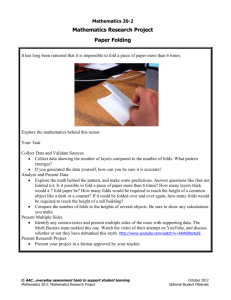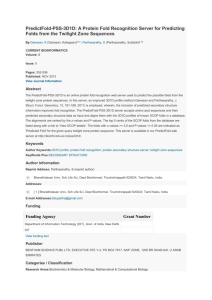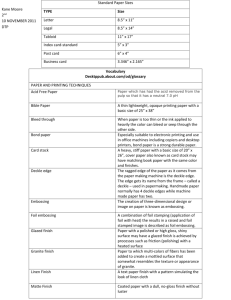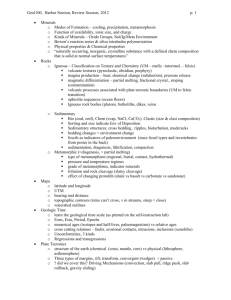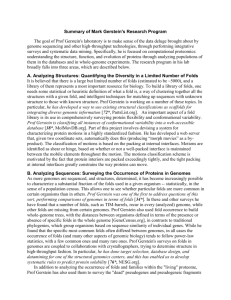nsb-db-integ-000906rev - Gerstein Lab Publications
advertisement
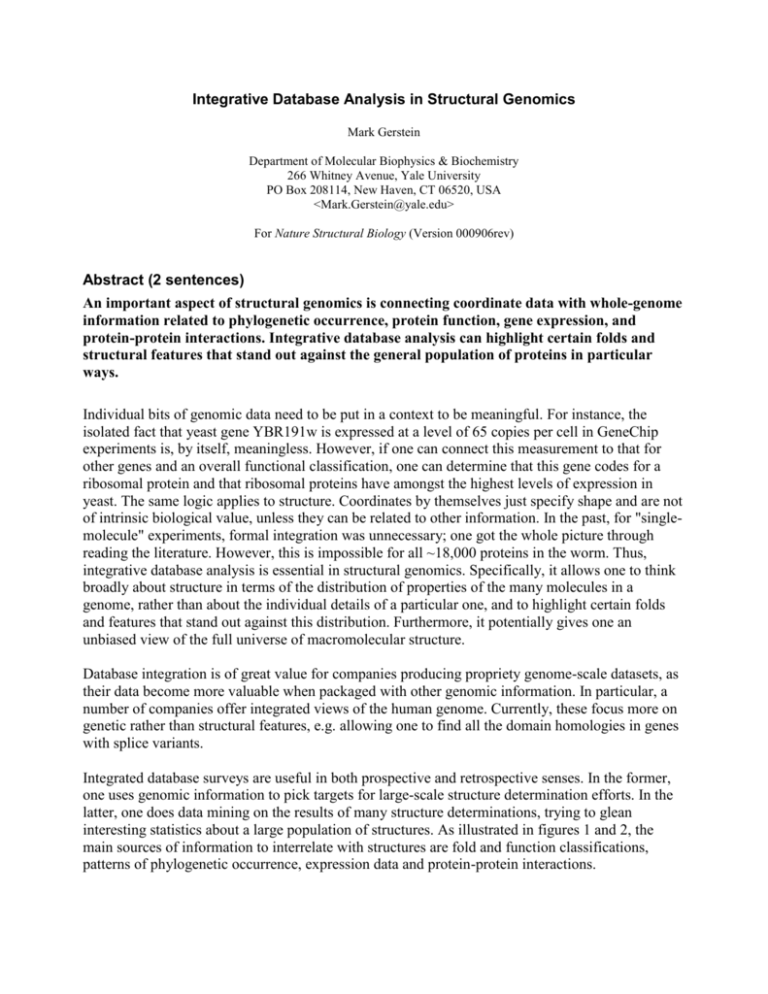
Integrative Database Analysis in Structural Genomics Mark Gerstein Department of Molecular Biophysics & Biochemistry 266 Whitney Avenue, Yale University PO Box 208114, New Haven, CT 06520, USA <Mark.Gerstein@yale.edu> For Nature Structural Biology (Version 000906rev) Abstract (2 sentences) An important aspect of structural genomics is connecting coordinate data with whole-genome information related to phylogenetic occurrence, protein function, gene expression, and protein-protein interactions. Integrative database analysis can highlight certain folds and structural features that stand out against the general population of proteins in particular ways. Individual bits of genomic data need to be put in a context to be meaningful. For instance, the isolated fact that yeast gene YBR191w is expressed at a level of 65 copies per cell in GeneChip experiments is, by itself, meaningless. However, if one can connect this measurement to that for other genes and an overall functional classification, one can determine that this gene codes for a ribosomal protein and that ribosomal proteins have amongst the highest levels of expression in yeast. The same logic applies to structure. Coordinates by themselves just specify shape and are not of intrinsic biological value, unless they can be related to other information. In the past, for "singlemolecule" experiments, formal integration was unnecessary; one got the whole picture through reading the literature. However, this is impossible for all ~18,000 proteins in the worm. Thus, integrative database analysis is essential in structural genomics. Specifically, it allows one to think broadly about structure in terms of the distribution of properties of the many molecules in a genome, rather than about the individual details of a particular one, and to highlight certain folds and features that stand out against this distribution. Furthermore, it potentially gives one an unbiased view of the full universe of macromolecular structure. Database integration is of great value for companies producing propriety genome-scale datasets, as their data become more valuable when packaged with other genomic information. In particular, a number of companies offer integrated views of the human genome. Currently, these focus more on genetic rather than structural features, e.g. allowing one to find all the domain homologies in genes with splice variants. Integrated database surveys are useful in both prospective and retrospective senses. In the former, one uses genomic information to pick targets for large-scale structure determination efforts. In the latter, one does data mining on the results of many structure determinations, trying to glean interesting statistics about a large population of structures. As illustrated in figures 1 and 2, the main sources of information to interrelate with structures are fold and function classifications, patterns of phylogenetic occurrence, expression data and protein-protein interactions. The Finite Parts List, Fold classifications and Genome Fold Assignment A key driving idea in structural genomics is that of a finite list of protein "parts," a sort of lego-kit from which all proteins can be assembled. Parts can be defined as sequence modules, in terms of families of homologous sequences (e.g. from PFAM, PROTOMAP, CDD, COGs1,2,3) and associated structures. Alternatively, they can be defined as folds purely based on similarity of 3Dstructure, with one fold combining a number of sequence modules. The fact that the number of folds is considerably smaller than that of modules provides a valuable simplification in interpreting complex genomic information (though there is the complication that folds can unite analogous rather than distantly homologous sequences). There are a number of different classifications of folds, either derived from manual or automatic structure comparison (e.g. SCOP, CATH, FSSP4,5,6). For structural genomics, these are essential for putting individual structures into proper context in fold space and measuring the scale of the structure databank and its rate of increase. By one measure there are ~550 known protein folds (scop 1.50), and it is estimated in total there are only 1000-10000 folds7,8. To directly cross-reference folds against genomes one needs sensitive procedures for sequence comparison with the sequences corresponding to known structures. There are a variety of techniques for this, ranging from standard and reliable pairwise comparison (e.g. fasta and blast9,10), to multiple-sequence comparison (PSI-blast and variants11,12), to more sensitive, though more speculative, threading methods13,14. One important issue in these calculations is the degree that they are biased by the incomplete nature of the structure databank and the varying sensitivity of some comparison programs, especially the profile-based ones, which find disproportionately more homologs for certain families15. Phylogenetic Occurrence Information If one carefully tracks the species of each sequence assigned a fold, one can use structural genomics to address certain evolutionary questions16,17: Are specific folds associated with particular phylogenetic groups, i.e. are there metazoan-only folds? To what degree are folds shared between related organisms and does this degree of sharing parallel measures of relatedness derived from the traditional evolutionary trees? Initial analyses indicate that the sharing of folds does indeed parallel the traditional tree18. Furthermore, one can look at the prevalence of particular folds in various organisms. Initial surveys show that the frequency of folds differs considerably among organisms but there are a few folds, such as the TIM-barrel and P-loop NTP hydrolase folds, that are common in all genomes studied19. While these analyses are useful retrospectively, the phylogenetic distribution of folds and sequence families is also useful prospectively in target selection.† One can choose to focus on folds and families unique to an organism or those shared amongst many organisms -- i.e. atypical or typical proteins. A sequence-based clustering of proteins can readily identify large, shared families that represent typical proteins. Alternatively, folds and families unique to pathogenic organisms may provide good drug targets. Functional Classification and Protein-Protein Interactions Integrated structural-genomics analysis must include functional classification. However, there is currently no "universal" classification, covering all functions in all organisms, that could be applied uniformly to all structures. Most of the existing schemes (e.g. GO, MIPS, GenProtEC, Enzyme, COG2,20,21,22,23) focus on all functions in specific organisms or specific functions (e.g. enzymes) across many different organisms. Furthermore, the classifications mean different things when they refer to function, conflating biochemical mechanism, cellular role, and phenotypic manifestation, e.g. "is hydrolase" vs. "in glycolytic pathway" vs. "gets cancer when mutated". Finally, many proteins have multiple functions and some functions require multiple proteins. One of the greatest potential retrospective uses of structural genomics is making more precise the annotation of biochemical function. Certain folds are related to specific biochemical functions and, broadly, certain classes of folds tend to be associated with certain classes of function (e.g. alpha/beta folds with enzymes)24,25.‡ Moreover, the concept of "fold" while not perfect is more precise than that of "function," and there is a clearly defined relationship between the degree of similarity in sequence and the corresponding degree of similarity in structure, while the analogous relationship for function is less well understood.26,27 One can take these ideas further and, prospectively, try to predict function just given structure. This is in essence a speculative extrapolation from the known fold-function relationships in the database. The existence of folds that have many functions confounds this to some degree. However, there are actually only a few multipurpose scaffolds, with most folds only having a single function, suggesting that function prediction may be realistic for a subset of proteins (figure 2).20,24 (This situation has a direct analogue in day-to-day experience, where given the shape of a mechanical part one can usually, but not always, guess what it does.) Protein function is often closely related to protein-protein interactions. The structure databank itself and some whole-genome experiments (in particular, yeast two-hybrid28) now allow one to survey interactions on a large-scale and relate them to structure. Broadly, one sees patterns, such as folds with many interactions having many functions (figure 2). One of the most interesting questions suggested by such comprehensive data is the prediction of the entire protein-protein interaction map for an organism given all the structures in its genome. That is, can one correctly dock the structures in an organism's parts list to predict their associations? Expression Data and Related Functional-Genomics Information A most exciting new source of information is whole-genome expression data, which gives the level of expression of a particular gene in the context of all the genes in the genome (reviewed in 29,30). 2D-gel experiments provide analogous information on cellular protein abundance31, and for select organisms there is further related genomic information, such as the essentiality of a given gene and the subcellular localization of its protein product22,32. Overall these functional genomics datasets are the by far the largest source of information in genomics; for yeast, they now dwarf the information in the sequence alone. Combining expression information with genome fold assignments allows one to see whether highly expressed or highly abundant proteins share particular features, which might, for instance, better stabilize them33. Expression timecourses may also be useful for detecting and studying proteins in large complexes and proteins that strongly interact,34 as these often show concerted changes in expression. Finally, expression information will be useful prospectively in target selection, for highlighting proteins that may be more readily expressed and purified. Technical Issues: Interconnecting Federated Databases The most important issue in integrative database analysis and datamining is determining scientifically relevant questions to address and interesting statistics to compute. One cannot understand how to structure, build, and interrelate genomic and structural databases in the abstract without a sense of the types of questions that integration can address. Furthermore, beyond conventional relational databases, robust file systems, and standard statistical techniques, there are few generic tools and approaches. That said, one of the major practical issues confronting structural genomics today is bringing together on the computer many different datasets. This process differs depending on the overall architecture of the information: whether it is stored in a single centralized repository or in a federation of different resources. The former has the advantages of efficiency and uniformity and is the solution adopted by the major archival databases, GenBank and the PDB§. It clearly works well for bulk data in standardized formats, e.g. coordinates and sequences. However, much of the information generated by functional and structural genomics projects will be more heterogeneous, e.g. large-scale datasets on crystallizability or the binding of metabolites to batteries of proteins. Furthermore, it will be collected in many locations, reflecting the distributed character of biological research. It is impossible for all this information to be kept in a single repository in a single format; rather, it will be stored in distributed resources. This federated structure has the advantage that it can harness many people in the genome annotation effort. Moreover, it is similar in spirit to the open-source software movement, which gave rise to the popular linux operating system. Given the federated structure of genomic information, one has the problem of database interoperability35,36. Currently, the most common interface involves reports on a single protein "joined" together by web hyperlinks. This provides a simple and effective way of traversing multiple information resources for a single protein. However, it is ineffective for genome-scale queries. There are a variety of technologies (e.g CORBA, SRS37) for addressing this, and a number of novel approaches for creating virtual meta-databases through which one can perform queries across many information sources. Nevertheless, at present the solution often adopted is transferring structured data files. Ideally these come in standard formats (e.g. XML, ASN.1) with metadata describing their contents. For effective use, all these approaches require more standardized biological nomenclature than we currently have, and there are a number of proposals for creating ontologies and controlled vocabularies for biological function and structure23,38. Specifying a version history on information is also essential; in reporting the results of a database survey reproducibly one needs a way of referring to particular "frozen" snapshots of a number of continually growing databases. The major information resource in science is the literature. This is often not discussed in the way databases are, but it should be39. Papers are the historical way sequences and structures have been "annotated". With the advent of on-line journals and the way they can be queried in an integrated fashion (via PubMed), there will be little difference between future databases and on-line journals - or between curators and editors. Conclusion: Structure as the "Final" Annotation for the Human Genome Structural information can and should be tightly integrated with genomic information. Now that the human genome has been sequenced, attention is turning to annotation. Considering a long time horizon, one can see that there will be essentially an infinite amount of resources for annotating the human genome. Given this, what would one want as the "final" annotation for the genome? Structure will undoubtedly be vital. It connects the genome to molecular information, which is invaluable for pharmaceuticals. Moreover, structural domains provide a natural way of specifying a basic unit in annotation, as the definition of modules purely in terms of conserved sequence motifs is not nearly as unambiguous and rigorous. Finally, the definition of protein fold, while not perfect, is more precise than that of function, providing a valuable reference point in annotation. Acknowledgements Thanks are given to Martin Schultz, Dov Greenbaum, Paul Bertone, Werner Krebs, Perry Miller, and Kei Cheung for carefully reading the draft; to S Teichmann and J Park for providing proteinprotein interaction numbers for the figures; and to the NIH and Keck foundation for financial support. Figure 1 An example of structural-genomics data integration is shown for yeast. The figure shows the ten most common folds in the yeast genome and the rankings these have when they have arranged according to other measures than level of genome duplication. It gives an overview of the degree to which the common parts in yeast occur in other genomes, are prevalent in the PDB, have many functions and interactions, and are highly expressed. In general, ranking is useful for bringing together many disparate properties of folds into a common numerical framework. In the table, the numbers and color coding indicate the rank, with black for the top ranked, followed by dark gray for ranks between 2 and 5, light gray for ranks between 5 and 10, and so on. A zero is shown as a box with a slash, and when a fold is not ranked according to a particular attribute its associated box is empty. Specific discussion of the ranking attributes in each column follows. The columns headed "phylogenetic occurrence" (B to G) show the rankings of each fold in a number of other representative genomes. (These are based on previously described sequence comparison of genomic sequences against the PDB 19,24.) The columns headed "fold classification" show some typical ways of ranking folds based on their prevalence in the structure databank (based on alignments of proteins in PDB from 27). Column H shows a rough ranking in terms of frequency in the PDB, and column I shows how each fold places against all others in the databank when ranked in terms of the overall structural similarity of the representatives of the fold. The columns headed "Gene Expression Data" show rankings of folds from weighting them by either their mRNA population (column J) 33 using data from 34 or in terms of the degree to which they change in expression during a gene-expression timecourse (either "cell cycle" or "sporulation", columns K or L). Column M shows how additional functional genomics information can be integrated. This column shows the sensitivity of each fold (i.e. of all ORFs containing that fold) to an inserted transposon when yeast is grown in a specific condition 32. Finally, the columns headed "Function & Interactions" show how the common yeast folds rank in terms of the number of interaction in the 2- hybrid experiment28 (column N) or in terms of the number of functions (column O, as defined in 24). Further fold rankings are available from bioinfo.mbb.yale.edu/partslist. Figure 2 Results of an integrated database analysis on the relationship between fold and function and its implications for structural genomics. The figure shows a histogram of the number of folds with a given number of functions -- from previous tabulations 20,24. Only a few folds, which are highlighted, have many functions, whereas most have only one or two functions. This has implications for data mining and function prediction based on structural genomics. In particular, it implies that if a structure with an unknown function is solved, one may be able to confidently infer function if is it is not one of the few multi-functional folds. The number of interactions that the five most multifunctional folds have with other structures in the PDB is indicated in the top panel. This highlights how folds with many functions also have many interactions. References 1. Sonnhammer, E.L., Eddy, S.R., Birney, E., Bateman, A. & Durbin, R. Pfam: multiple sequence alignments and HMM-profiles of protein domains. Nucleic Acids Res 26, 320-2 (1998). 2. Tatusov, R.L., Koonin, E.V. & Lipman, D.J. A genomic perspective on protein families. Science 278, 631-7 (1997). 3. Yona, G., Linial, N. & Linial, M. ProtoMap: automatic classification of protein sequences and hierarchy of protein families. Nucleic Acids Res 28, 49-55 (2000). 4. Holm, L. & Sander, C. The FSSP database of structurally aligned protein fold families. Nuc. Acid Res. 22, 36003609 (1994). 5. Murzin, A., Brenner, S.E., Hubbard, T. & Chothia, C. SCOP: A Structural Classification of Proteins for the Investigation of Sequences and Structures. J. Mol. Biol. 247, 536-540 (1995). 6. Orengo, C.A., et al. CATH--a hierarchic classification of protein domain structures. Structure 5, 1093-108 (1997). 7. Brenner, S.E., Chothia, C. & Hubbard, T.J. Population statistics of protein structures: lessons from structural classifications. Curr Opin Struct Biol 7, 369-76 (1997). 8. Wolf, Y.I., Grishin, N.V. & Koonin, E.V. Estimating the Number of Protein Folds and Families from Complete Genome Data. J. Mol. Biol. 299, 897-905 (2000). 9. Altschul, S., Gish, W., Miller, W., Myers, E.W. & Lipman, D.J. Basic local alignment search tool. J. Mol. Biol. 215, 403-410 (1990). 10. Pearson, W.R. Empirical statistical estimates for sequence similarity searches. J Mol Biol 276, 71-84 (1998). 11. Altschul, S.F., et al. Gapped BLAST and PSI-BLAST: a new generation of protein database search programs. Nucleic Acids Res 25, 3389-402 (1997). 12. Kelley, L.A., MacCallum, R.M. & Sternberg, M.J. Enhanced genome annotation using structural profiles in the program 3D- PSSM. J Mol Biol 299, 523-44 (2000). 13. Fischer, D. & Eisenberg, D. Predicting structures for genome proteins. Curr Opin Struct Biol 9, 208-11 (1999). 14. Jones, D.T. GenTHREADER: an efficient and reliable protein fold recognition method for genomic sequences. J. Mol. Biol. 287, (1999). 15. Gerstein, M. How Representative are the Known Structures of the Proteins in a Complete Genome? A Comprehensive Structural Census. Folding & Design 3, 497-512 (1998). 16. Gerstein, M. A Structural Census of Genomes: Comparing Eukaryotic, Bacterial and Archaeal Genomes in terms of Protein Structure. J. Mol. Biol. 274, 562-576 (1997). 17. Wolf, Y.I., Brenner, S.E., Bash, P.A. & Koonin, E.V. Distribution of protein folds in the three superkingdoms of life. Genome Res 9, 17-26 (1999). 18. Lin, J. & Gerstein, M. Whole-genome trees based on the occurrence of folds and orthologs: implications for comparing genomes on different levels. Genome Res 10, 808-18 (2000). 19. Gerstein, M. Patterns of Protein-Fold Usage in Eight Microbial Genomes: A Comprehensive Structural Census. Proteins 33, 518-534 (1998). 20. Thornton, J.M., Orengo, C.A., Todd, A.E. & Pearl, F.M. Protein folds, functions and evolution. J Mol Biol 293, 333-42 (1999). 21. Karp, P.D., et al. The EcoCyc and MetaCyc databases. Nucleic Acids Res 28, 56-9 (2000). 22. Mewes, H.W., et al. MIPS: a database for genomes and protein sequences. Nucleic Acids Res 27, 44-8 (1999). 23. Ashburner, M., et al. Gene ontology: tool for the unification of biology. The Gene Ontology Consortium. Nat Genet 25, 25-9 (2000). 24. Hegyi, H. & Gerstein, M. The relationship between protein structure and function: a comprehensive survey with application to the yeast genome. J Mol Biol 288, 147-64 (1999). 25. Martin, A.C., et al. Protein folds and functions. Structure 6, 875-84 (1998). 26. Chothia, C. & Lesk, A.M. The relation between the divergence of sequence and structure in proteins. EMBO J. 5, 823-826 (1986). 27. Wilson, C.A., Kreychman, J. & Gerstein, M. Assessing Annotation Transfer for Genomics: Quantifying the Relations between Protein Sequence, Structure and Function through Traditional and Probabilistic Scores. J Mol Biol 297, 233-249 (2000). 28. Uetz, P., et al. A comprehensive analysis of protein-protein interactions in Saccharomyces cerevisiae. Nature 403, 623-7 (2000). 29. Lipshutz, R.J., Fodor, S.P., Gingeras, T.R. & Lockhart, D.J. High density synthetic oligonucleotide arrays. Nat Genet 21, 20-4 (1999). 30. Brown, P.O. & Botstein, D. Exploring the new world of the genome with DNA microarrays. Nat Genet 21, 33-7 (1999). 31. Gygi, S.P., Rochon, Y., Franza, B.R. & Aebersold, R. Correlation between protein and mRNA abundance in yeast. Mol Cell Biol 19, 1720-30 (1999). 32. Ross-Macdonald, P., et al. Large-scale analysis of the yeast genome by transposon tagging and gene disruption. Nature 402, 413-8 (1999). 33. Jansen, R. & Gerstein, M. Analysis of the Yeast Transcriptome with Broad Structural and Functional Categories: Characterizing Highly Expressed Proteins. Nuc. Acids Res. 28, 1481-1488 (2000). 34. Holstege, F.C., et al. Dissecting the regulatory circuitry of a eukaryotic genome. Cell 95, 717-28 (1998). 35. Frishman, D., Heumann, K., Lesk, A. & Mewes, H.W. Comprehensive, comprehensible, distributed and intelligent databases: current status. Bioinformatics 14, 551-61 (1998). 36. Davidson, S.B., Overton, C. & Buneman, P. Challenges in integrating biological data sources. J Comput Biol 2, 557-72 (1995). 37. Etzold, T., Ulyanov, A. & Argos, P. SRS: information retrieval system for molecular biology data banks. Methods Enzymol 266, 114-28 (1996). 38. Westbrook, J.D. & Bourne, P.E. STAR/mmCIF: an ontology for macromolecular structure. Bioinformatics 16, 159-68 (2000). 39. Gerstein, M. E-publishing on the Web: promises, pitfalls, and payoffs for bioinformatics. Bioinformatics 15, 42931 (1999). † See the article on target selection by S Brenner in the supplement for more detail on this topic. See the article on structure-function relationships by J Thornton in the supplement for more detail on this topic. § See the article on the PDB by H Berman in the supplement for more detail on this topic. ‡
